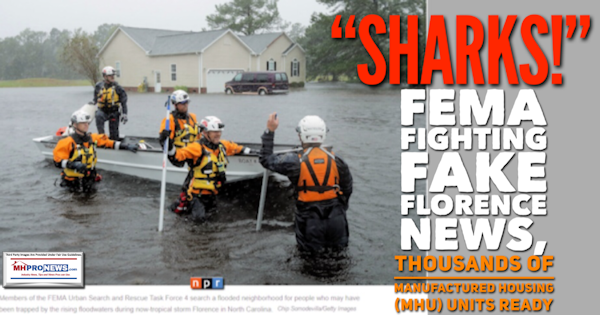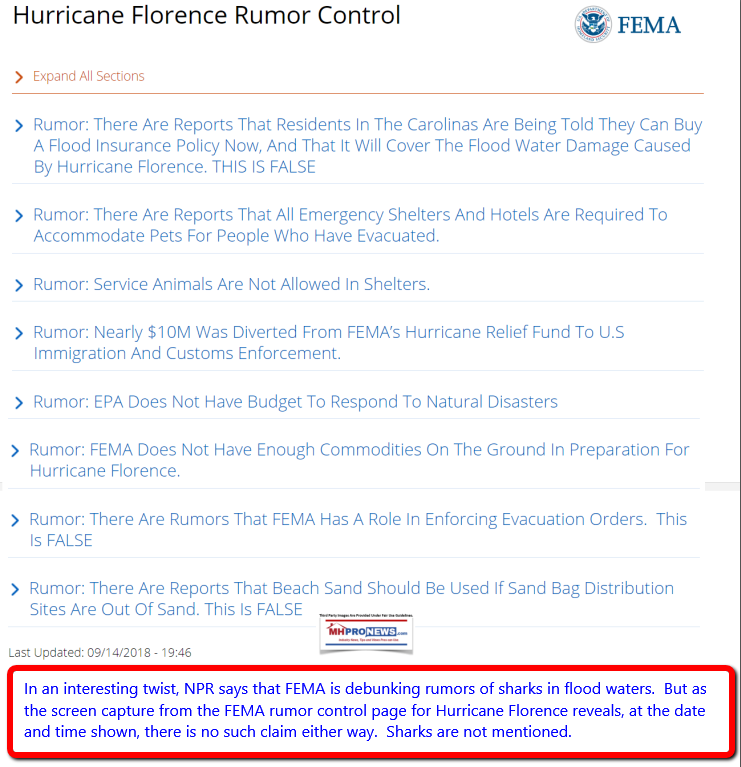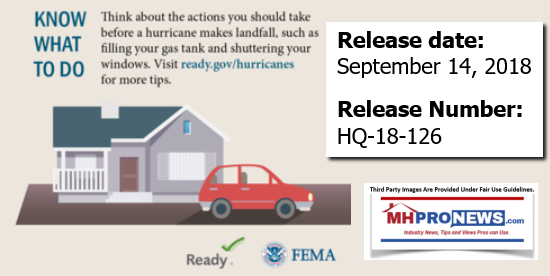
Friday evening a North Carolina source told the Daily Business News on MHProNews the following.
“Widespread power outage[s] and flooding. 100 plus winds on coast. Many counties have no power at all (total loss of power). Nuclear plant shut down (intentionally) in Brunswick County. But still better than what was forecast on Tuesday (in my opinion). Not able to find out what is really going on in coastal counties because my contacts aren’t available. Sorry for the brevity but I don’t have power and trying to save power on phone.”
Manufactured Housing Related
Reuters is reporting that FEMA has “thousands” of pre-positioned Manufactured Housing Units (MHUs) for post-storm recovery.
Multiple sources have told MHProNews that RVs are going to be the units of first choice in some scenarios, a claim that our media relations sources at FEMA have not yet confirmed nor denied.
That said, a FEMA video suggests that both kinds of temporary housing units – RVs and MHUs – are part of the FEMA response portfolio. One source said that the decision is made in part based upon how many are going to be in the disaster housing relief unit.
There are conflicting claims that indicate that some HUD Code manufacturers, sellers and associations have been contacted, while others have not. There are several possible explanations for that, ranging from favoritism being shown to certain producers and trade groups, to urgencies, distractions, and disruption of efforts to try to work with all possible resources on an even-handed basis.
That noted, FEMA and past disasters have raised serious concerns, see the related reports, further below.
MHProNews will continue to try to clear such points of concern with respect to Hurricane Florence, and update readers next week as the initial stresses created by the storm for those responding begins to clear.
Death, and “Fake News” About Sharks in the Water
There are several reported deaths, related to winds, water, and fallen trees. The winds were not as severe as initially expected, but flooding is likely to be as serious an initial as was feared by forecasters.
NPR says that fighting fake news in the form of rumors, often spread by social media, is being fought by FEMA through a new rumor debunking page.
Per NPR, “Unfounded rumors — what might be called “fake news” — have been a problem in coping with recent disasters, according to Gary Webb, a professor and chair of emergency management and disaster science at the University of North Texas.”
“Disasters do create a great deal of uncertainty, confusion and anxiety,” Webb said, “and, as a result, there is the potential for rumors to propagate.”
Webb gave an example that during Hurricane Katrina, “Vicious rumors circulated about violent assaults happening at the Superdome and convention center.”
Among the items NPR says FEMA is discouraging are reports that there are sharks in the flood waters. NPR calls it a recurring hoax, complete with fake photos. But what’s interesting about this claim is that the FEMA rumors page this morning has no such claim either way, it is mute on the topic.

MHProNews isn’t speculating as to why there is a discrepancy between what NPR claims, and what the FEMA page shown above is reporting. That said, NPR has previously been accused by manufactured housing (MH) industry professionals of biased or ‘fake’ news reporting about MH industry related issues.

Release date:
September 14, 2018
Release Number:
HQ-18-126
WASHINGTON – Hurricane Florence is impacting portions of the eastern United States, and will continue to batter the mid-Atlantic with high winds, storm surge, and heavy rains today. Dangerous flooding is already occurring across the North and South Carolina coasts; residents and visitors should remain indoors until told by local officials that it safe to go outside.
“This is going to be a long duration, frustrating event; we won’t be able to fix the broken infrastructure while the storm is under way. But we are going to be there to support all those who need us,” said FEMA Administrator Brock Long. “Our job is to pre-deploy our assets and teams to help the heroes at the state and local level do their jobs and backfill their capabilities. Search and rescue is our greatest focus right now as well as stabilizing critical lifelines.”
Residents in North Carolina, South Carolina, Georgia, and Virginia should:
- Text, don’t call. During an emergency, phones lines may be overwhelmed. To let your loved ones know you are safe, send a text instead.
- Save power. If the power goes out, turn off or disconnect appliances, equipment, or electronics. Power may return with momentary “surges” or “spikes” that can cause damage. Only use a generator or other gasoline-powered machinery outdoors and away from windows.
- Let first responders do their job. Stay off the roads, beaches, and waterways. Use VHF Channel 16, or call 911 for emergency needs.
Federal Activities as of 5 a.m. Eastern
Federal Emergency Management Agency (FEMA)
- FEMA Incident Management Assistance Teams are at state emergency operations centers in the Carolinas, Virginia and Washington D.C. to support readiness and response activities and ensure there are no unmet needs.
- FEMA Urban Search and Rescue teams and U.S. Coast Guard resources are positioned in the Carolinas, Maryland, and Virginia to quickly mobilize to support search and rescue efforts as requested by potentially affected states.
- FEMA has Mobile Emergency Response Support (MERS) units in North Carolina and South Carolina with secure and non-secure voice, video and information services to support states’ emergency response communications needs.
- Additional mobile communications resources are pre-positioned in Virginia, West Virginia, Alabama and Tennessee to support potentially affected areas as needed and requested.
- The National Flood Insurance Program (NFIP) is working closely with Insurance Commissioners in North Carolina, South Carolina, Georgia, Virginia and Maryland to monitor the situation, and support any additional unmet needs.
- The NFIP held preparation calls with all NFIP Write Your Own private-sector partners to ensure they help deliver customer-centric claims service on the NFIP’s behalf. Partners reported they have nearly 3,000 flood-certified adjusters ready to respond to Hurricane Florence.
FEMA Logistics and Commodities Movements
- The private sector is the first source for goods in the potentially affected areas. When their supply chain is disrupted, or stores are unable to open, then state, local and voluntary agencies will provide needed supplies. FEMA, working in coordination with the state, will augment state and local resources as needed and requested.
- At all times, FEMA maintains commodities, including millions of liters of water, millions of meals and hundreds of thousands of blankets,
- FEMA is forward staging meals, water, cots, blankets and other resources at Incident Support Bases, distribution centers, and pre-positioning sites in the Carolinas, Georgia, Virginia and West Virginia, to support the needs of the state as they exhaust their supplies until stores can reopen. The quantity of supplies on hand will fluctuate as supplies are continuously moving.
American Red Cross
- The American Red Cross is responding across multiple states as Hurricane Florence begins to pound coastal and inland communities with catastrophic flooding and life-threatening tidal surges.
- More than 14,000 people spent Wednesday night in over 200 Red Cross and community shelters across South Carolina, North Carolina and Virginia.
- More than 1,500 disaster workers are on the ground to help and additional volunteers are being mobilized now in case they are needed.
- The Red Cross has mobilized about 80 emergency response vehicles and more than 120 trailers of equipment and relief supplies to support relief efforts.
- Working with partners, the Red Cross has served 4,500 meals and snacks.
- Since Tuesday, more than 1.8 million weather alerts have been sent through Red Cross apps to help people make lifesaving decisions.
Corporation for National and Community Service
- The Corporation for National and Community Service has activated nearly 500 members of the AmeriCorps Disaster Response Team. This includes 12 FEMA Corps teams requested by FEMA to support distribution centers, incident staging bases, survivor assistance, personnel staging, and Incident Management Assistance Teams, as well as another nine AmeriCorps teams to support shelter operations in North and South Carolina.
- 180 additional AmeriCorps members serving with FEMA Corps have been pre-staged at the AmeriCorps campus in Vicksburg, Miss. All remaining available AmeriCorps Disaster Response Teams are on standby, with 140 AmeriCorps members activated for possible deployment.
- These expertly trained crews provide support for shelter operations, call centers, volunteer and donation management, muck and gut operations, blue-roof tarping, debris cleanup, and other services. Working with local partners, CNCS is also surveying current on-the-ground AmeriCorps and Senior Corps programming for potential reassignment once the storm clears.
U.S. Department of Defense
- U.S. Northern Command (USNORTHCOM) is leaning forward and actively posturing U.S. Department of Defense(DoD) forces in preparation for Hurricane Florence.
- The DoD’s Defense Logistics Agency has mobile distribution centers established in the region and is prepared to provide and distribute more than 281,000 gallons of fuel for federal response. They have also pre-staged 60 generators and transformers to support critical infrastructure, and are prepared to provide shelf stable meals and bottled water in coordination with FEMA.
- USNORTHCOM has available amphibious ships USS Kearsarge (LHD 3) and USS Arlington (LPD 24), along with embarked elements of the 22nd Marine Expeditionary Unit and the Expeditionary Strike Group 2 command element. The ships will be positioned to provide Defense Support to Civil Authorities (DSCA) from the sea as needed and requested.
- In response to potential flooding, DoD is preparing ground transportation/high-water capable vehicles to move personnel and cargo in the affected areas, is preparing to provide rotary wing aircraft, swift water boats and rescue personnel in support of flooding in the affected areas.
National Guard Bureau
- The National Guard has approximately 4,000 soldiers and airmen already on-duty, which is expected to significantly increase in the coming days. Over 10 states are mobilizing critical support from their National Guard forces through the Emergency Management Assistance Compact to the anticipated impacted areas. Approximately 40 rotary wing aircrafts are available for search and rescue, and the National Guard will provide general support missions with the local first responders.
U.S. Army Corps of Engineers
- U.S. Army Corps of Engineers (USACE) teams are on the ground in the Carolinas and Virginia to assist states and tribes with temporary emergency power, debris removal, infrastructure assessments, water and wastewater assessment and temporary roofing.
- USACE has deployed 85 personnel and seven Deployable Tactical Operations Center Vehicles to assist with communication capabilities.
U.S. Department of Energy
- The Department of Energy (DOE) is continuing to work with its partners to respond to the impact of Hurricane Florence. DOE responders are working with their counterparts in the field, and more than 40,000 workers from at least 17 states have been mobilized to support restoration efforts.
- Crews will begin working as soon as it is safe to do so, though power restoration may take several days or even more in some areas.
- DOE has also begun to issue Event Summaries on the impacts of Florence to the energy infrastructure, which can be found here.
Nuclear Regulatory Commission
- The Nuclear Regulatory Commission (NRC) oversees eight nuclear power plants, including 13 reactors, in or near the projected path of Hurricane Florence. (Three sites in North Carolina, three sites in South Carolina, and two in Virginia.)
- U.S. nuclear power plants are designed to deal with severe natural phenomena including hurricanes. The NRC is confident the plants in the path of Hurricane Florence are prepared for the projected conditions of the storm and its aftermath.
- Plant procedures require operators to shut down the reactor before hurricane-force winds arrive on site. The Brunswick, N.C. completed emergency shut down operations.
- The NRC’s resident inspectors at each plant have completed reviews of storm preparations by the licensees. Additional inspectors and staff are at potentially affected plants and state emergency operations centers.
- The NRC activated its Region II Incident Response Center in Atlanta on Thursday evening to provide oversight of the agency’s response to the storm.
Environmental Protection Agency
- On Thursday, the U.S. Environmental Protection Agency granted Georgia’s request from to revise its emergency fuel waiver to allow the sale and distribution of gasoline with a Reid vapor pressure of up to 11.5 pounds per square inch before the addition of any ethanol. EPA has granted this revised temporary waiver to help ensure that an adequate supply of gasoline is available until normal supply to the region can be restored.
- The EPA Oil Program contacted 25 coastal North Carolina and South Carolina Facility Response Plan facilities to assess readiness and verify contacts for post-storm assessments.
- EPA staff are compiling a list of Superfund sites in Georgia, as well as a total number of Risk Management Plan facilities, Federal Response Plan facilities, drinking water systems, and wastewater treatment systems to help them as they prepare their response plans.
U.S. Department of Health and Human Services
- U.S. Health and Human Services (HHS) medical personnel began providing care for residents who evacuated to general population shelters in southern Virginia.
- HHS now has more than 500 medical personnel pre-positioned from the U.S. Public Health Service Commissioned Corps, National Disaster Medical System, Centers for Disease Control and Prevention, and other HHS divisions, along with caches of medical equipment and two 50-bed Federal Medical Stations so these assets are available quickly anywhere they are needed to help state and local authorities respond to communities’ medical needs. Approximately 300 ambulances and their emergency medical crews are on standby to assist.
U.S. Department of Homeland Security National Protection and Programs Directorate
- DHS’ National Protection and Programs Directorate (NPPD) has stood up its Crisis Action Team (CAT) in support of Hurricane Florence. The CAT provides NPPD with the flexibility to rapidly expand operational focus and support affected cyber and critical infrastructure partners at the state, local, tribal and territorial government levels.
Customs and Border Protection
- U.S. Border Patrol agents from the Laredo Sector Mobile Response Team are deployed to North Carolina to assist in law enforcement support, urban search and rescue efforts as Hurricane Florence approaches the Atlantic Coast. The deployment of Border Patrol assets is a coordinated effort between numerous federal, state and local agencies.
- An initial cadre from the Special Operations Detachment Unit, which includes EMT-certified Border Patrol Search, Trauma and Rescue (BORSTAR) agents, specializes in urban search and rescue as well as swift water rescue and marine operations, is also in North Carolina. The deployment includes riverine assets and swift water rescue equipment. Border Patrol agents from the Laredo Sector have integrated efforts with Border Patrol assets across the country in anticipation of search and rescue operations in the mid-Atlantic associated with Hurricane Florence.
- CBP Air and Marine Operations (AMO) Black Hawk crews are on the ground in Virginia, and additional crews are traveling from locations throughout the United States, to include Jacksonville, Florida, Tucson, Arizona, San Diego and Miami, and stage in Manassas, Virginia until able to fly into affected areas. AMO crews are preparing for rescue efforts following the hurricane.
U.S. Coast Guard
- The U.S. Coast Guard has personnel and assets permanently assigned throughout the region, and the service has pre-staged Shallow Water Response Boats and teams in Georgia and North Carolina for rapid deployment after impact.
- USCG deployed 13 Incident Management Assistance Team members to Charleston, S.C., and Goldsboro, N.C..
- USCG search and rescue surge aircraft are at the air station in Savannah, Ga. to prepare for an immediate response.
- USCG Deployable Specialized Forces are setting up across the Atlantic coast ahead of the storm to provide additional response capacity.
- Elements of the USCG Maritime Safety and Security Teams, Tactical Law Enforcement Teams, Incident Management Assist Team, and National Strike Force are deploying to pre-stage in areas from Augusta, Ga., up to Raleigh, N.C.
- 58 Maritime Security and Safety Team personnel, including four response boats and crews are pre-staged in Augusta, Ga.
- USCG deployed 17 National Strike Force members deployed to Raleigh, N.C., and Greensboro, N.C. to assist with hazmat assessment.
U.S. Department of Housing and Urban Development
- The Department of Housing and Urban Development has been in contact with all housing authorities and multifamily property owners within the projected storm area to ensure residents are safe.
U.S. Department of the Interior
- The entire Department of the Interior is actively monitoring Hurricane Florence and its expected impact on the Eastern shore of the United States. We are working closely with our federal, state, and local partners to ensure the proper response to the storm. The National Park Service, U.S. Geological Survey, U.S. Fish and Wildlife Service, and the Bureau of Indian Affairs are implementing preventative measures in preparation for the Hurricane.
U.S. Geological Survey
- The U.S. Geological Survey (USGS) crews installed storm-tide sensors at key locations along the North and South Carolina coasts in advance of Hurricane Florence.
- In addition to storm-tide sensors, 25 rapid deployment gauges were installed at critical locations that may be impacted by storm surge or floodwaters, but where the USGS does not have permanent stream gages.
- The USGS is coordinating with the National Weather Service, FEMA, and state and local agencies to put the rapid deployment gauges in places with the greatest need. They will augment a network of 231 stream gages in North Carolina and 112 stream gages in South Carolina that provide critical information to the National Weather Service, FEMA and other USGS partners involved in issuing flood and evacuation warnings and in coordinating emergency responses to communities.
U.S. Fish and Wildlife Service
- The U.S. Fish and Wildlife Service is mobilizing heavy equipment task forces and law enforcement teams to get into the impact zones as quickly as possible. They will start assisting wildlife refuges and communities hit by the hurricane as soon as it is safe.
- Staffers from the Service and other agencies will make rescue operations for communities their first priority, and will be securing and repairing the infrastructure of the national wildlife refuge system.
U.S. Department of Justice
- The U.S. Department of Justice is monitoring the situation closely, and is in touch with its components and facilities in the impacted region. Law enforcement components stand ready to answer calls for assistance from state and local entities.
U.S. Department of Labor
- As part of its commitment to state and local partners facing a serious impact by Hurricane Florence, U.S. Department of Labor announced it is ready to make available National Dislocated Worker Grant funding to help South Carolina assess its workforce needs.
National Oceanic & Atmospheric Administration
- Seven underwater “Hurricane Gliders” were deployed by the National Oceanic & Atmospheric Administration’s Integrated Ocean Observing System partners in advance of Hurricane Florence. Data from the gliders is available for assimilation into hurricane forecast models.
- Teams from NOAA are ready if needed to capture high-definition aerial photos from locations affected by the storm. These images help emergency managers assess the extent of damage and determine the appropriate response following landfall.
- NOAA is monitoring near real-time water levels and meteorological data for Hurricane Florence, and is ready to provide scientific support to assess damage from environmental pollution and marine debris.
- NOAA’s Navigation Response Teams are ready to deploy hydrographic survey assets, to help re-open our nation’s ports following the storm.
Salvation Army
- The Salvation Army has staged incident command teams and more than 60 mobile feeding units throughout Virginia, the Carolinas, and Georgia to provide relief to survivors and first responders as soon as storm conditions allow. Their main staging area is at the Charlotte Motor Speedway, where more than 20 canteens and one field kitchen (en route) are staged to deploy to impacted areas when weather permits.
- The Salvation Army is coordinating with, and supporting Carolina, state emergency operations centers and various shelters.
U.S. Small Business Administration
- The Small Business Administration (SBA) prepositioned our post-disaster teams and will coordinate with FEMA to deploy our response efforts.
Social Security Administration
- The Social Security Administration (SSA) closed several offices across North Carolina and South Carolina. The offices will remain closed at least through the end of this week. Where possible, SSA is making arrangements for field offices not impacted by the hurricane to provide assistance to the offices that are closed.
U.S. Department of State
- The U.S. Department of State Office of Foreign Missions (OFM) continues to distribute preparation messaging to foreign consular missions in affected zones.
U.S. Department of Transportation
- The U.S. Department of Transportation established a Routing Assistance Hotline to support the movement of federal, state, and local response personnel, equipment, and goods during Hurricane Florence response efforts.
Federal Aviation Administration
- The Federal Aviation Administration deployed a team to South Carolina to assist with airspace management.
USA.gov / GobiernoUSA.gov
- Published usa.gov/hurricane-florence and gobierno.usa.gov/huracan-florence as central hubs for communication efforts on what federal government is doing in response to Hurricane Florence.
- Updated our Tips for Preparing Published in English and Spanish – Highlights staying safe, preparing for power outages, and communicating with friends and family.
End of FEMA Media Release ##
See related reports, further below. That’s Saturday morning’s “News through the lens of manufactured homes, and factory-built housing,” © where “We Provide, You Decide.” © ## (News, analysis, and commentary.)
(Third party images and content are provided under fair use guidelines.)
1) To sign up in seconds for our MH Industry leading emailed news updates, click here.

2) To pro-vide a News Tips and/or Commentary, click the link to the left. Please note if comments are on-or-off the record, thank you.
3) Marketing, Web, Video, Consulting, Recruiting and Training Re-sources

Related Reports:
South Carolina’s State Association Was Pro-Active Ahead of Hurricane Florence
FEMA, Manufactured Housing Units, Behind the Scenes Look, Hurricane Florence Backgrounder
The Masthead
When money is earned, it can be spent. So it may seem odd to discuss profits as “false.” As anyone who’s watched the movie Scarface knows, crime is a business. It may be illegal, but it’s business. The risk/reward equation for a criminal enterprise is different than for a legal business.
Industry Voices
National Public Radio (NPR) did a two-part report released this week on manufactured home communities, part one of their controversial story – “Mobile Home Park Owners Can Spoil An Affordable American Dream ” – including initial manufactured home industry related responses, are linked here.
Media Bias, Ignorance, Manufactured Homes, Agenda Journalism, the Truth About “Fake News”

























